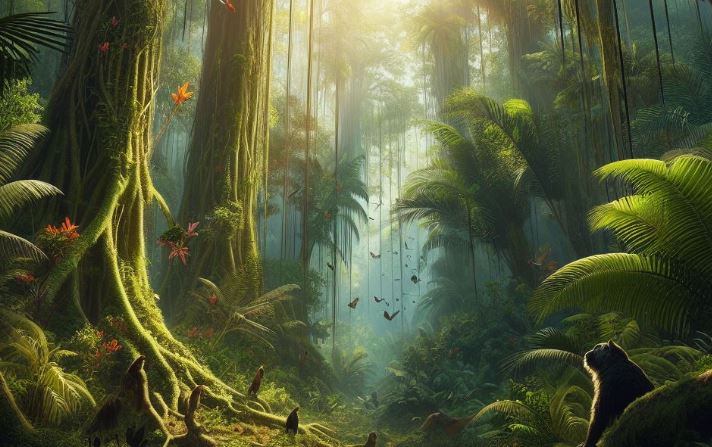Imagine waking up one day to find the entire world shrouded in a dense, impenetrable jungle. You step outside, and instead of the familiar sights of roads, buildings, and open spaces, all you see is an endless expanse of tangled greenery. The world as we know it has vanished beneath a cloak of vegetation, leaving behind a maze of towering trees and thick undergrowth. But what would life be like in such a world? How would humanity adapt to this drastic transformation?
What could cause such effects?
The reasons for this verdant takeover could be many, each with its own ripple effects. Perhaps runaway climate change has caused a dramatic rise in global temperatures and carbon dioxide levels, triggering a surge in plant growth. This scenario, sometimes referred to as hypertrophied growth, could see vegetation flourishing at an unprecedented rate, with rainforests expanding aggressively and encroaching on once-populated areas.
Alternatively, a cataclysmic event like a massive asteroid impact or supervolcanic eruption could have drastically altered the Earth’s climate, plunging the planet into a period of chaos. The resulting dust clouds could block out the sun for years, leading to a global winter that would devastate most life forms. However, once the dust settled and the climate began to stabilize, the hardier plant life could potentially experience a resurgence, slowly reclaiming the land in a long and arduous process.
What Would the Immediate Impact Be?
- Loss of Infrastructure: Imagine the streets of bustling cities swallowed by the relentless advance of nature. Buildings, roads, and bridges would be obscured by a thick carpet of vines and foliage, rendering our urban landscape unrecognizable. The infrastructure we rely on for transportation, communication, and commerce would be buried beneath layers of greenery, disrupting the rhythm of daily life.
- Disruption of Ecosystems: The sudden transformation would unleash a domino effect across ecosystems worldwide. Habitats would be altered or destroyed, displacing countless species of plants and animals. From the depths of the rainforest to the depths of the ocean, the balance of nature would be thrown into disarray, triggering a cascade of unforeseen consequences.
- Challenges to Transportation: Picture trying to navigate through a labyrinth of dense vegetation where once there were highways and railways. Traditional modes of transportation would become obsolete as roads disappear beneath the foliage. Travel would become arduous and fraught with danger, as explorers brave the impenetrable jungle in search of new routes and destinations.
How Would People Survive in the Impenetrable Jungle?
- Adaptation: In the face of adversity, humans have always demonstrated remarkable adaptability. In this new jungle world, we would need to evolve new skills and techniques to navigate the dense terrain. From mastering the art of tree-climbing to developing strategies for traversing swampy marshes, our survival would depend on our ability to adapt to the challenges of our environment.
- Resourcefulness: With the comforts of modern civilization stripped away, we would need to rely on our ingenuity to meet our basic needs. Hunting, fishing, and foraging would become essential skills as we seek out food sources in the wilderness. Building shelters from natural materials and purifying water from jungle streams would become everyday tasks in our quest for survival.
- Collaboration: Alone, we may struggle to survive in the harsh jungle environment. But together, we can overcome even the greatest challenges. Communities would form, united by the common goal of survival. Through cooperation and mutual support, we would pool our resources and expertise to thrive in this unfamiliar world.
What Would We Eat?
Supermarkets stocked with neatly packaged food would be a distant memory. Survival would depend on our ability to forage for edible plants, fruits, and nuts. Think wild berries, mushrooms (beware of poisonous varieties!), and grubs – yes, grubs! In this new world, insects might become a valuable source of protein, rich in essential fats and minerals.
But foraging wouldn’t be a walk in the park (or jungle, for that matter). Many plants and fungi would be unrecognizable to our modern eyes, requiring careful identification to avoid toxic lookalikes. Trial and error would certainly be part of the learning process, but knowledge would be passed down through generations, creating a deep cultural understanding of the jungle’s edible offerings.
Supplements would also likely be a thing of the past. The diverse flora of the jungle could provide a natural source of essential vitamins and minerals. Certain plants might be known for their medicinal properties, used to treat illnesses and injuries. Imagine a world where communities rely on herbal remedies passed down through generations.
Of course, hunting would also play a role in our jungle diet. Small animals, birds, and even insects could be potential sources of protein. Developing effective hunting techniques with spears, bows, and traps would be crucial. Learning animal behavior patterns and creating intricate traps from jungle materials would become essential skills for survival.
How Would the Society Evolve in this Impenetrable Jungle?
- Shift in Priorities: In a world consumed by an impenetrable jungle, survival would become our primary focus. The pursuit of wealth, status, and material possessions would fade into the background as we prioritize the essentials of life. Our values and priorities would undergo a profound transformation, reshaping the fabric of society.
- New Hierarchies: Leadership structures would emerge based on skills essential for jungle survival. Those with knowledge of navigation, hunting, and plant identification would rise to prominence, leading their communities through the challenges of the jungle. Traditional hierarchies based on wealth or social status would give way to a meritocracy based on practical skills and resilience.
- Technological Innovation: As we adapt to life in the jungle, we would harness our creativity and ingenuity to develop new technologies suited to our environment. Tools for clearing paths through the impenetrable jungle, harnessing renewable energy sources, and harvesting rainwater would become indispensable in our daily lives. Through innovation, we would carve out a sustainable existence amidst the wilderness.
What could be the Environmental Consequences of it?
- Biodiversity: While the initial transformation may lead to a decline in biodiversity due to habitat destruction, over time, the jungle could become a hotbed of evolutionary innovation. New species would emerge, adapted to the unique conditions of the impenetrable jungle, filling ecological niches left vacant by those that perished. The cycle of life would continue, albeit in a radically altered form.
- Climate Regulation: The dense vegetation of the jungle would play a crucial role in regulating the global climate. By absorbing carbon dioxide and releasing oxygen through photosynthesis, the jungle would act as a natural carbon sink, mitigating the effects of climate change. The preservation of these vital ecosystems would be essential for maintaining planetary stability.
- Ecosystem Services: Despite the challenges posed by living in an impenetrable jungle world, the ecosystem would continue to provide essential services to humanity. From pollination by tropical insects to the purification of water by rainforest plants, the jungle would sustain us in ways both seen and unseen. Preserving these ecosystem services would be essential for our long-term survival.
What kind of Challenges and Opportunities might arise out of it?
- Health Risks: Dense jungles can harbor various hazards, from venomous snakes to disease-carrying insects. However, they also offer untold opportunities for medicinal discovery. The rich biodiversity of the jungle could yield new treatments and cures for a myriad of ailments, providing hope for the future of healthcare.
- Cultural Transformation: Our relationship with nature would undergo a profound transformation in a world consumed by jungle. No longer separate from the wilderness, we would find ourselves immersed in its beauty and complexity on a daily basis. This newfound connection could inspire a cultural renaissance, as we rediscover our place within the natural world.
- Exploration and Discovery: The uncharted territories of the jungle world would beckon adventurers and scientists alike, offering endless opportunities for exploration and discovery. From the depths of unexplored caves to the heights of towering canopy trees, the jungle would hold secrets waiting to be uncovered. Every expedition would be an opportunity to expand our understanding of the world and ourselves.
While the idea of a world consumed by jungle may seem daunting, it also presents a unique opportunity for humanity to rediscover its connection to the natural world. By embracing the challenges and opportunities presented by this hypothetical scenario, we can envision a future where resilience, adaptability, and cooperation lead us through the dense undergrowth towards a new dawn of exploration and discovery.
In the end, whether our world remains a bustling metropolis or transforms into a lush jungle, one thing is certain: humanity’s capacity to thrive amidst adversity knows no bounds. So let’s dare to imagine, explore, and adapt, for it is in the face of the unknown that our true potential shines brightest.






